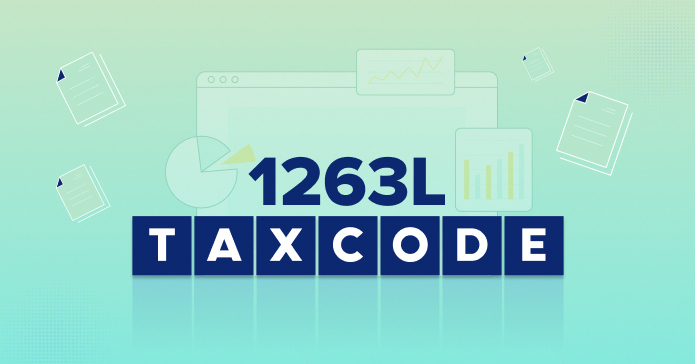Tax Code is never a fun subject, but an essential evil to be able to navigate the UK tax system especially when you're a small business owner or entrepreneur. One code that might come up is the 1263L tax code aka Father Christmas of all Tax Codes. If you’ve seen this on your tax documents and wondered what it means, you are getting relief from HMRC.
This blog post is here to demystify the 1263L tax code, explain its implications, and help you understand how it can benefit you.
What is the 1263L Tax Code?
The 1263L tax code indicates that you are eligible for HMRC's flat rate expenses for the costs and maintenance of your work uniform. Essentially, it means you receive tax relief to cover the upkeep of any necessary work attire, resulting in less tax paid overall.
Find more about how to claim a uniform tax rebate here.
Why Am I Paying Tax on 1263L?
When you see the 1263L tax code, it's natural to wonder why you're paying tax on it. The '1263' portion of the code signifies your Personal Allowance, which is the amount of income you can earn annually without paying tax. For the 1263L code, this amount is £12,630. This is slightly higher than the standard Personal Allowance of £12,570, denoted by the 1257L tax code.
In essence, the 1263L code gives you an additional £60 tax-free allowance, recognizing the costs related to maintaining your work uniform. This means that a portion of your income is shielded from tax, effectively reducing your overall tax burden.
Why is My Tax Code 1263L and Not 1257L?
You might be wondering why your tax code is 1263L instead of the more common 1257L Tax Code . The difference lies in the additional tax-free allowance provided by the 1263L code. This additional allowance is specifically for individuals who incur costs related to the maintenance of their work attire. If your job requires you to wear and maintain a uniform, you are eligible for this extra relief, hence the 1263L designation.
What Does an 'L' Tax Code Mean?
The 'L' at the end of your tax code is significant. It indicates that you are entitled to the standard Personal Allowance. This means you'll receive the typical rate of tax-free income as determined by HMRC. If your tax code ends with 'L,' you can rest assured that you're benefiting from the usual tax-free income rate.
How to Determine if You're Eligible for the 1263L Tax Code
To determine if you're eligible for the 1263L tax code, you need to assess whether you incur expenses related to the maintenance of a work uniform. If your job requires specific attire that you must clean and maintain, you likely qualify for this tax relief.
Employers often inform HMRC about employees who are eligible for this relief, but it’s also a good idea to confirm with your HR department or tax professional to ensure you’re receiving the appropriate tax code.
Understanding the Benefits of the 1263L Tax Code
The benefits of the 1263L tax code extend beyond just a higher Personal Allowance. Here are a few key advantages:
- Reduced Tax Liability: With an additional £60 tax-free income, your overall tax liability decreases.
- Recognition of Work-Related Expenses: The 1263L tax code acknowledges the costs associated with maintaining a work uniform, providing financial relief.
- Simplified Tax Filing: By using a specific tax code for uniform maintenance, HMRC simplifies the process of claiming these expenses, making tax filing more straightforward.
How the 1263L Tax Code Impacts Your Take-Home Pay
One of the most immediate effects of the 1263L tax code is on your take-home pay. By increasing your tax-free allowance, the code ensures that more of your earnings stay in your pocket. This can be particularly beneficial for small business owners and entrepreneurs who are often looking for ways to maximize their income and minimize expenses.
To find out the exact take-home pay, use our Tax Calculators.
To see the impact on your take-home pay, compare your earnings under the 1257L and 1263L tax codes. You’ll notice that the additional £60 tax-free allowance provided by the 1263L code results in slightly higher net income.
Common Misconceptions About the 1263L Tax Code
Like many tax-related topics, the 1263L tax code is often misunderstood. Here are some common misconceptions:
- It’s Only for High Earners: The 1263L code is not limited to high earners. Any eligible individual incurring uniform maintenance costs can benefit.
- It’s Automatically Applied: While many employers inform HMRC about eligible employees, it’s essential to verify with your HR department or tax professional.
- It’s a Permanent Code: Your tax code can change based on your circumstances. If your job requirements change, so might your eligibility for the 1263L code.
How to Change Your Tax Code?
If you believe you’re eligible for the 1263L tax code but have not been assigned it, you can request a change. Here’s how:
- Contact HMRC: Reach out to HMRC directly via phone or their online portal.
- Provide Documentation: Be ready to provide evidence of your uniform maintenance expenses.
- Update Your Employer: Inform your employer about the change to ensure your payroll reflects the updated tax code.
Summary and Taking Action
In summary, the 1263L tax code offers valuable tax relief for individuals who incur costs related to maintaining a work uniform. By understanding its implications and taking proactive steps, you can maximize your tax benefits and improve your overall financial health.
For those looking to explore more about tax codes and their benefits, consider consulting with a tax professional or visiting HMRC’s official website for the latest information.
Stay updated, stay informed, and ensure you’re making the most of your tax allowances!
For further reading on tax codes take a look at;













